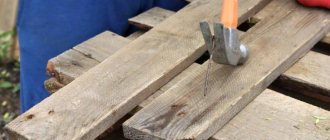Flower care in September
Author: Natalya February 13, 2021 Category: Garden plants
Autumn has arrived... The mornings are already fresh, the evenings are cool, but the day is still as hot as summer, although this is not for long. At the beginning of autumn, the garden is full of asters, rudbeckias, dahlias, anemones, sedums, gladioli, hydrangeas, roses, climbing roses, spirea and heather, autumn crocuses and colchicums, but there is no time to admire them while basking in the gentle autumn sun - there is no end to the work. It will soon rain and get colder, and you need to have time to prepare the garden and plants for the end of the season.
Garden work in September
Autumn flowers are still blooming, and summer flowers are already preparing for dormancy. In the first week of September, daffodils will be planted, and in the second week, phloxes, astilbes, delphiniums and other perennials will be transplanted. At the same time, planting of all bulbous plants begins - muscari, tulips, lilies. Dahlias are planted up to 20 cm in height to protect the buds on the root collar from sudden frosts. Rhododendrons and peonies are fed with phosphorus and potassium.
At the end of September, standard and climbing roses will need to be hilled up high and bent to the ground, then the tubers of dahlias, cannas and begonias will be removed from the soil, and if frost hits, then you need to hurry up with digging up the gladioli. The stems of faded perennials are trimmed. September is the time to collect seeds. Here is an approximate list of work that needs to be done in the garden in the first month of autumn.
Caring for perennial flowers
Watering flowers
The growing season is coming to an end, but the flowers still need your attention. Caring for flowers in September includes, as in the spring-summer period, watering, fertilizing, loosening the soil and removing weeds, however, watering flowers in September is carried out much less frequently, since faded or fading plants need much less water. If precipitation falls regularly, watering is reduced to a minimum or stopped altogether. Roses, for example, are no longer watered at all in September. However, the flowers you have planted or transplanted need plenty of watering.
Feeding flowers
In September, flowers are fertilized with phosphorus and potassium; nitrogen-containing fertilizers are not applied to the soil. Moreover, only perennial plants are fed. Fertilizers in dry form are scattered around the site, embedded in the soil, which is then watered. Annual flowers are not fed in the fall - after you remove their plant debris from the site, you can add fertilizer to the soil so that in the spring or late autumn you can sow the seeds of flowers that will decorate your garden next year.
Loosening and weeding
After watering, it is much easier to loosen the soil in the flowerbed and remove weeds - this still needs to be done in September, because some flowers are just beginning to bloom, and if you do not remove the weeds, they can choke out the flowers that you have been waiting for, or will take away from them nutrition. In addition, a good owner should have cleanliness and order in his flowerbed at any time of the year.
Sheltering plants for the winter
Winter is the hardest period for plants and the most serious test they can face in their gardens. Of course, native species, well-adapted to the regional climate, can cope with almost any eventuality. But in flowerbeds and garden beds there are many plants that, despite their high frost resistance, do not like unstable winters; they overwinter only under snow or in the absence of winter thaws, for fear of getting wet. And this is not to mention crops with insufficient winter hardiness that require special shelter. And no matter how carefully you select types and varieties, there is no single recipe for success. Plants need an individual approach in everything, including preparation for winter. Implementing a personal approach in the fall, when every minute counts and so much needs to be done, is not easy. But if you want your large and small flower beds to delight you for many years, they, or rather each planted plant, will have to be given attention.
The timing of shelter is always selected according to the weather. Clematis and roses are the first to begin preparing for covering, as this process will take several weeks. And they always focus on the weather: they start sheltering when stable night frosts appear. Typically, the process of final preparation for winter begins in mid-October; bulbous and spring-flowering plants are mulched and covered, as a rule, until the end of October. The remaining perennials can be covered at the same time, but it is better to wait until the soil freezes at least 5 cm.
Among the crops that winter without problems in the middle zone and, apart from general preparation measures, do not require any shelter are classic and hardy garden perennials. Irises, perennial poppies, winter-hardy asters, delphinium, aquilegia, lupins, hostas, paniculate and spreading phlox overwinter just as well as bergenia, cornflowers, astilbe, muscari, daffodils, tiger and Daurian lilies, geraniums, sedums, lungwort, aconite, nivaria and milkweeds.
Sheltering ornamental plants for the winter.
But such favorite plants as varietal lilies, hyacinths, hybrid tulips, pansies, violets, periwinkles, bells, carnations, peonies, and daisies require at least light shelter. They do not like snowless winters, dampness and temperature changes. You don’t have to work on a complex “wrap”: such perennials overwinter well under a light hilling, a layer of dry leaves, spruce branches, when mulching the soil around the clumps with peat, compost, sawdust or straw with a layer of about 10 cm. Peat is very often recommended for wrapping those prone to bulging from plant soil, such as daisies and pansies, but in a pinch just soil will do. The creation of shelter is carried out with the arrival of stable night frosts. Young plants will need the same type of shelter in their first winter, as will all biennials.
Low-winter-hardy plants need much more serious shelter, like vines on supports and trunks decorating flower beds. The latter are bent to the ground, but the steeplejack must be removed from the support. Otherwise, covering plants is carried out using standard technology for covering roses and clematis. After pruning (if the plants need it), the plants are covered with soil, compost, peat or humus, covered with dry leaves, and a shelter is created on top from spruce branches or branches, non-woven materials or a combination thereof. You can also resort to air-dry shelter by installing a frame around the bushes and wrapping it with non-woven material or film with vents for ventilation. You need to start wrapping in advance, allocating at least a few days, or better yet, a week for each stage-layer. Hilling up is enough for plants before the beginning of winter. The last layers of shelter are installed only when the temperature drops below -5 degrees, the soil freezes 5 cm or more, and even then cracks and vents are left in it until severe frosts arrive. Wrapping it up too early is more dangerous than being late, because the plants may simply dry out. On warm days, the shelter should be ventilated in the future.
Caring for annual flowers
Caring for flowering annuals
Flowering annuals are cared for in the same way as perennials - watered, weeded, and loosened the soil on the site. But annual autumn flowers do not need feeding at this time. If you want to collect the seeds of the annuals you like, do not forget to mark several flowers from which you will then collect the seeds, and cut off the remaining flowers as they fade to prevent self-seeding.
Caring for annuals that have already bloomed
Those annuals that have already bloomed should be slowly removed from the garden, making room for other plants or to prepare the area for the next season. It is better to burn the plant remains of wilted annual flowers, since harmful insects or pathogenic fungi, viruses and bacteria could have settled in them. The soil on which annuals grew is watered with Fitosporin or sprinkled with ash for disinfection purposes, and then loosened.
Planting flowers in September
What flowers are planted in September
In September, biennial flowers are planted - daisies, violas, forget-me-nots, Turkish carnations, foxgloves and others. In the first half of the month, small-bulbous crops are planted - snowdrops, scillas (scilla), muscari, crocuses, chionodoxes. From the beginning of the second ten days of September, they begin to plant bulbs - daffodils, and in the second half of the month - tulips. The turn of hyacinths begins at the end of September, although if you have a lot of worries, you can postpone planting hyacinths until the beginning of October.
Planting biennials in open ground
If you grew seedlings of daisies, forget-me-nots, Turkish carnations, bluebells or pansies in the summer, then by September the seedlings should already be “ripe” for transplanting into open ground in places that should be prepared 3-4 weeks before planting. Biennials are planted at a distance of 20 cm from each other, and Turkish cloves and bluebells - at a distance of 30 cm. Tall mallows or foxgloves require an interval of 40 cm. If the soil is dry, after planting the seedlings in the ground, it should be watered generously and mulched with a layer of compost, humus or peat 3-4 cm thick.
Don’t forget to pinch the tops of the seedlings a week before planting so that the plants form a bush faster.
Planting perennials in open ground
In addition to seedlings of biennial plants, seedlings of perennials grown in a greenhouse - aquilegia, delphinium, yarrow, chamomile, echinacea, mallow, pyrethrum - are also planted at the same time. When planting, make sure that the soil does not get into the middle of the bush. After planting, water the seedlings generously, squeeze the soil around it and mulch it with humus, sawdust, peat or sand.
Ways to plant flowers in September
Before planting small bulbous plants, treat the planting material in a solution of foundationazole or other fungicide. The planting depth should be equal to three diameters of the bulb, that is, the larger the bulb, the deeper it should be planted. The bottom of the bulb placed in the hole should be directed straight down. Large bulbs are planted at a distance of 12 cm from each other, small ones - at intervals of 5-7 cm. If the weather is dry and warm, water the planting.
Dig up tubers and bulbs
In the first half of autumn, tubers and bulbs of dahlias, begonias, and gladioli are prepared for digging. Since they are dug up after the onset of frost, they are only earthed up during this period to protect them from frost.
Related article:
Flower garden in the apartment
In the middle or second half of autumn (depending on the region), when frost sets in, these flowers are cut off at the root, the corms are dug up, washed, kept in a fungicidal solution, dried and stored.
Transplanting flowers in September
How and when to replant flowers
The first month of autumn is the deadline for dividing and replanting peonies, astilbe, phlox and delphinium, as well as lilies, if you did not do this in August. The peony bush is dug up on one side at a distance of 25 cm from the bush, then they begin to rock the bush until its roots are released. The roots are carefully cleared of soil, the bush is placed in the shade, allowing the roots to dry a little, then the remaining soil is shaken off, the stems are cut, the roots are washed with water and the bush is divided into approximately equal parts with a sharp sterile instrument. The cuts are treated with crushed coal and parts of the bush are planted, in no case burying the root collar into the soil.
How to feed rhododendron in the fall?
Rhododendron does not need to be fed in the fall. The last feeding occurs in mid-to-late July. Before frost arrives, it is necessary to mulch the soil under the rhododendron with rotted manure (5 cm layer) to help the roots survive the winter.
Don't neglect other plants in your garden: they also need your support and help in preparing for the cold.
Flower pruning
Remember to remove faded flowers, dried flower stalks and dead leaves from flowering perennials to keep them looking attractive before they wilt. If the entire plant has dried out, cut it off entirely, leaving only a five-centimeter stump. For irises and peonies, if you are not going to replant them, cut off all the stems in this way, and spray the remaining bushes with a one percent solution of Bordeaux mixture.
After flowering, phloxes are also cut almost to ground level, and the stumps are sprinkled with ash. It is customary to cut off the buds on roses in the second half of September, since they are unlikely to have time to bloom, but can take away the nutrients necessary for wintering from the bush. Do not cut long-stemmed flowers from rose bushes, as this will provoke the growth of a new shoot, and it is unlikely to have time to ripen before winter, so the plant will waste energy and nutrition on its growth.
Caring for flowers after flowering
Faded annuals are disposed of, and perennials, as a rule, have their stems cut almost to soil level. It is better to destroy plant residues, dig up the soil around the trimmed plants and treat it and the plant itself with a one percent solution of Bordeaux mixture. Half a bucket of manure is poured around the peonies (not on the bush itself) or two buckets of peat. Those perennial plants that are afraid of frost should be covered with mulch after cutting off the ground parts and preventive treatment.
Caring for flowers in early autumn
At the beginning of autumn, there is a lot of summer work in the flower garden: weeding, loosening, watering in dry weather. Asters, rudbeckia and marigolds require special care.
In addition, the first half of the month is favorable for the propagation, planting and replanting of perennial flowers. Many gardeners begin these activities at the end of August, because late planting of perennials often leads to death, especially in the case of an early, frosty and little snow winter.
In many “long-lasting” flowers, in the fifth year of life, weak stems form, flowers become smaller, diseases appear, because every year new buds are formed, rhizomes and roots grow, crowding each other. Most perennial flowers are large plants, and over the years the soil under them becomes increasingly depleted.
Rudbeckias in a flower garden. Photo: extension.umass.edu
Perennials that do not have wintering basal leaves (delphinium, rudbeckia, phlox) are dug up and their faded stems are cut off. If you can’t divide the bush into pieces with your hands, you can use a knife, a sharp shovel or an ax.
Young parts that have formed large, full-fledged buds, which are usually located on the periphery of the bush, are selected for planting. They must have renewal buds and a piece of rhizome with roots. And the thickest, oldest and damaged roots are not used for propagation. The sections are treated with crushed charcoal.
Perennials that overwinter in the form of a rosette with basal leaves (daylily, bergenia, iris, heuchera) are divided, preserving the leaves. In such perennials, renewal buds, from which flowering stems will develop next year, are laid in the axils of the leaves or in the center of the rosette.
The most popular perennials
- Rose . “Queen of Flowers” is the name given to this plant, which is especially popular among gardeners. You probably won’t find a single garden plot where these beautiful flowers are not grown. From June to October, the rose delights us with its flowers and persistent intoxicating aroma. Roses are small and large, bush and border, climbing and semi-climbing, double and simple, with a cup-shaped, goblet-shaped, cone-shaped bud. Roses are full of colorful colors, playing with tints from soft white to red and black. Roses are usually planted in the center of the flower bed, since this flower is the most important decoration of the flower garden.
- Carnation . A flower with a lush lacy inflorescence, a delicate and pleasant aroma and a variety of colors. Carnations grow white, red, yellow-white with a red rim. They look very nice in a flowerbed as a group planting. They are easy to care for and are resistant to diseases.
- Pansies. This is the name of the tricolor violet. One small flower contains several different flowers. Basically, these are brown, yellow, lilac colors. Pansies are low-growing border plants that are planted along the edge of a flower bed, thus forming a hedge. They bloom throughout the summer.
- Lily. A very beautiful flower, distinguished by a fairly large bell-bud size and a pleasant smell. Lilies come in white and yellow, red and pink, with stripes and specks. Several bell buds grow on a high stem, thinning out the wonderful aroma. They bloom in June.
- Phloxes. This flower is a cap of small flowers gathered together on a tall stem. Phlox ranges from soft pink to dark lilac. The delicate aroma of phlox can be heard from afar. They begin to bloom in June and bloom until September.
- Bells. This flower begins to bloom in late spring and produces new buds until autumn. Stems with small multi-colored buds extend from the cap of green foliage. The flower is very unpretentious, easily propagated by seeds and, if uncontrolled, can occupy the entire flowerbed.
- Hyacinths. A low-growing flower with a strong, pungent aroma. It begins to grow immediately after the snow melts and the temperature rises, even not significantly. The first flowers appear in April and May. A panicle consisting of small flowers rises above the green foliage. Hyacinths come in white, pink, blue, red, and purple.
- Irises. This regal flower has an unusual shape. Several stems grow from the bush, reaching a height of about 70 centimeters, they reveal a bud of incredible shape and beauty. Hybrid varieties of iris have a delicate aroma, while in ordinary varieties it is practically absent. This flower is planted in city flower beds, near shops and offices. Blooms in June, July.
- Daffodils. White and yellow handsome daffodils are sure to meet at your summer cottage. The bulb of this flower awakens in early spring. Arrow leaves grow, very similar to stems, and on one such leaf a bud appears, opens, blooms bright white or yellow. The buds are very beautifully shaped, the edges of the middle of the flower are red, wavy, and protrude outward. The flower has a strong intoxicating aroma. Blooms at the end of May, beginning of June.
- Tulips. There are a huge number of species of this plant with a wide range of colors. Tulips differ in the shape of the bud, the length of the stem, the shape and size of the leaf blade. The bulbs awaken and begin to grow as soon as the snow melts. Tulips bloom in open ground from May to mid-June. After flowering, the leaves dry out and fall off, the bulb goes deep into the ground until the next season.
- Peonies. Large flowers, peculiar caps, grown from the huge leaf mass of the bush. The bud is very beautifully composed, consists of small and large petals, and has a strong delicate aroma. Peonies come in white, red, pink, and burgundy. The first flower appears in June, the bush fades in July. Even after cutting off the flowers, the foliage of the bush remains green and large until autumn.
We plant hazel grouse in September
September is the month of planting bulbs. The key to success when propagating by bulbs is deep cultivation and proper soil filling.
In early September, hazel grouse (fritillaria) are planted. The imperial hazel grouse has very large bulbs, up to 12 cm in diameter. Depth of planting the bulbs The same layer of soil will be absorbed by the roots, so a hole up to 50 cm deep is prepared for planting, and its bottom is loosened with a pitchfork.
On clay soils, a 10 cm layer of fine crushed stone is poured into the bottom of the pit, and a 20 cm layer of it is covered with a mixture of humus, sand and garden soil in equal parts with the addition of lime (100 g), simple superphosphate (50 g) and potassium sulfate (30 g) .
The onion is placed bottom down in the center of the hole on a sand cushion (5 cm) and covered with sand. Then the hole is filled flush with the edges with garden soil. When planting several bulbs, they are placed at a distance of 20 cm from each other. Properly planted hazel grouse grow well and bloom in one place for many years.
Plant bulbous flowers and sow annuals
Plant spring bulbous plants in September-October. Do not forget that the bulbs are placed bottom down (only the bulbs of the imperial hazel grouse are laid on their sides).
- 11 most frequently asked questions about planting bulbs
We answer the most popular questions about bulbous plants.
Also, before winter, sow seeds of annual plants such as cornflowers, iberis, calendula, and eschscholzia. These flowers are easy to care for and bloom for quite a long time.
Caring for flowers in autumn
Share this article with friends:
In the fall, there are often blessed days when you want to put aside the most urgent matters and spend some time in the garden. Flowers at this time look unusually touching. Trees and shrubs changing their colors add color to the garden.
Autumn chores in the garden.
All this beauty will soon face severe winter trials, and it is in our power to help the plants survive the upcoming cold more easily. This article will discuss how to care for flowers and other decorative plants in the fall.
Caring for perennial flowers
Winter-hardy perennials ( daylilies, perennial asters, delphiniums, yarrows, oriental poppies, purple coneflower, autumn helenium, etc.) need very little help: prune after frost, leaving short stumps, loosen the soil around the bushes. If we didn’t have time to feed in September, we will apply phosphorus-potassium fertilizers under the bushes: 2 tbsp. spoons of superphosphate and potassium sulfate per sq. m.
There is no need to insulate winter-hardy plants, and yet, if possible, mulch them with compost or good humus, and later cover them with fallen leaves in case of snowless frosts. If there is not enough compost, we will first sprinkle on plants that have not been divided or replanted for a long time: they overwinter worse than young, well-established plants.
Late-planted plants will also require a little shelter: by winter they may not take root well enough. Even peonies, which are characterized by increased winter hardiness, if they are planted in the fall, are best mulched with humus or compost.
With heucheras it’s the other way around: they overwinter well at a young age, but over time their growth buds, rising above the soil level, can suffer in snowless winters. Therefore, it is recommended to add soil to “aged” heuchera , as well as primroses and paniculata in the fall. With the onset of stable cold weather, we add soil to the rhizomes of irises in order to rake it out early in the spring.
What to do with lilies
Asian lily hybrids do not require shelter . When preparing them for winter, we cut off the stems and make sure that during periods of winter thaws their area will not be flooded with melt water. If there is such a danger, we make diversion grooves.
For less winter-hardy oriental and trumpet lilies, we will stock up on insulation materials: leaves, grass, compost. We will cover these lilies after the first frost.
Spring primroses
Spring perennial garden flowers are the most long-awaited . They appear after long winter days. In order for primroses to bloom in the spring, they must be planted in September. It is better to root small bulbous flowers first, and then hyacinths, daffodils and tulips.
Compost and wood ash should be added to the dug soil and watered with a raspberry-colored solution of potassium permanganate. After planting, the ground should be mulched with peat and covered with leaves. The following species are considered early spring perennial flowers for the garden:
- Siberian scilla. The first flowers appear at the end of April. The flowers are bright blue with dark stripes on the petals. Snowdrops and spring whiteflowers go well with it. Also, Siberian bluegrass will look spectacular on the lawn, between trees and shrubs.
- Erythronium (kandyk). In early May, lilac-pink flowers with dark and light spots bloom. Suitable for planting next to muscari, primrose or pushkinia. Blooms profusely in both sunny and semi-shaded places. Erythronium tubers require large amounts of potassium and are drought tolerant.
- Spring whiteflower. Begins to bloom in the second half of April. Its flowers are white with a green spot. Scilla, muscari, pushkinia and primrose will look harmonious next to the white flower. Places with loose, fertilized soil in partial shade are suitable for it.
- Muscari grape-shaped. Flowering time is May, flowers are blue-violet. Its neighbors in the flowerbed can be tulips, daffodils and snowdrops. Unpretentious to the planting site and soil composition. Both sunny and shady places are suitable for it. Muscari can be planted between stones or trees, on an outdoor lawn.
How to feed strawberries during flowering: how to fertilize strawberries correctly and what is the best way to fertilize them? The best recipes and care tips (85 photos)
How to care for roses in autumn
the climbing roses from the trellises bend them down, tie them up, and place them (preferably not on the ground, but on boards, plastic boxes lined up in a row so that the shoots do not come into contact with the ground). Preparation for the shelter must be completed before frost, until the shoots lose their elasticity.
We will cover climbing roses with film or non-woven material, leaving vents on the sides, and we will cover them with leaves later - after the first frost.
We also need to take care of the roses and prepare a winter shelter for them.
We cover clematis that bloomed on last year’s shoots in much the same way.
We are not in a hurry to cover the bush roses: let them harden at gradually lowering temperatures. In addition, under cover in warm weather, fungal diseases actively develop, and roses may die.
We cut the rose shoots to mature wood and remove the damaged ones. We also cut off the leaves. We treat roses with copper-containing preparations (1% Bordeaux mixture, abi-ha-pic, 3% copper sulfate solution). While the soil is not frozen, we hill up the base of the bushes to a height of 15-20 cm. You can not hill up, but sprinkle the bushes with compost, dry soil, mixing it with sand (a bucket per bush).
What flowers are planted in autumn?
In October you can plant roses and other ornamental shrubs. The soil will not freeze for a long time, and the plants will have time to take root in the new place. We cover young rose bushes for the winter in the same way as adults. Be sure to mulch the soil around other new plantings. Under a layer of compost or leaves, the soil remains moist and warm for a long time, i.e., favorable for root growth.
You can plant roses in the fall.
We plant bush roses half a meter apart from each other.
In October we plant bulbs: first - daffodils, hyacinths , and towards the end of the month - tulips. Bulbs purchased in a store, as a rule, do not need pre-planting treatment (they have already been treated), but bulbs dug up in your own plot or donated by friends are best treated against diseases with the fungicide Maxim-dachanik: soak for half an hour in a solution (2 ml per liter of water), then dry and plant.
We plant the bulbs that we plan to dig up next season more often - every 10-15 cm, so that the flowering is spectacular. If we are not going to dig it up, we will plant it less frequently, leaving room for the nest of bulbs to grow.
There is no great need to “insulate” tulips, although a layer of compost or humus will not hurt them: in the spring the flowers will be larger and the flower stalks will be longer.
You need to take care of hyacinths and daffodils by sprinkling the planting site with compost, humus, and throwing leaves. After snowless winters, “lunges” occur in the plantings of these bulbous plants. The bulbs will not necessarily die, but will not bloom if frost damages the flower buds.
We dig up tubers of gladioli and dahlias
In October, it's time to dig up gladioli corms . But if thrips have worked on the plants (colorless “striations” and “spots” on the leaves and petals), it is advisable to treat them with an insecticide a week before digging ( alatar - 5 ml, actara - 8 g per 10 l).
If the time for treating gladioli is missed, it is pointless to treat in cold weather (thrips goes to “winter” under the covering scales of the corms), you will have to treat after digging. Having dug up the corms of the gladioli, we cut off the stems, leaving 5-6 cm of stumps. Dry them for a month in a warm place.
After the first frost we dig up dahlias.
We also dig up the roots of dahlias and the rhizomes of cannas and, without shaking them off the ground, lower them into storage and cover them with sand or sawdust. We place the cut stems and leaves in a compost heap, sprinkle with wood ash, cover with soil, and moisten.
Organics in autumn
Organic fertilizers are slow-release fertilizers. They help restore the amount of humus and improve the biochemical parameters of the soil. In sandy soils, organic matter lingers for a short time, in chernozem, loam, sandstone - longer, therefore the frequency of application is influenced by the quality characteristics of the soil.
- Cattle manure, bird droppings. It cannot be applied fresh to plants - the decomposition process is accompanied by an increase in soil temperature, which is detrimental to the roots, but applied during autumn digging it will enrich the soil with nitrogen and microelements. Before use, the litter must be diluted in water so that the caustic fertilizer is distributed evenly.
The planting depth should be 10-15 cm, otherwise all the beneficial substances will go deeper and the roots will not receive enough nutrition. It is recommended to feed with fresh manure no more than once every 4-5 years, using 1 bucket/1 m².
- Humus, compost. It takes two years to prepare a high-quality composition. For many crops, only mature compost (humus) is suitable, but not completely rotted compost can be used for autumn digging. The placement depth is from 10 to 15 cm, the consumption rate is from 3 to 4 kg/1 m². It is convenient to mulch (a layer no thicker than 7 cm) the soil on ridges, under perennials, under the crowns of bushes and trees with compost and humus.
- Ash. The best composition is obtained by burning healthy potato tops and garden tree branches. When digging, apply 1 kg per square area, frequency of application - no more than once every 3 years.
- Green manure. Planting various green manures at the end of August will saturate the soil with nitrogen, and plowing (necessarily before flowering) will make the soil loose and nutritious.
- Bone flour. It decomposes for a long time, providing the earth with phosphorus and potassium; apply at intervals of three years. Concentrated fat-free 35% flour contains much more phosphorus than other types of flour.
- Peat. Used together with humus and compost to retain moisture and add looseness. High peat has a high pH and the ability to retain moisture, but it contains few useful substances; low-lying peat has a slightly acidic reaction and a higher nutrient content.











